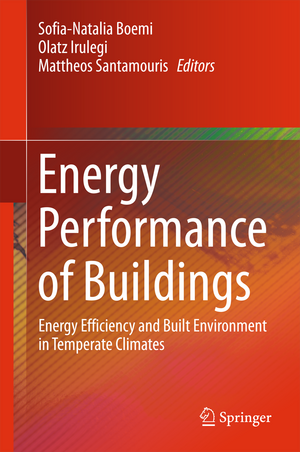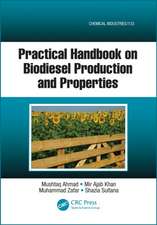Energy Performance of Buildings: Energy Efficiency and Built Environment in Temperate Climates
Editat de Sofia-Natalia Boemi, Olatz Irulegi, Mattheos Santamourisen Limba Engleză Hardback – 3 dec 2015
| Toate formatele și edițiile | Preț | Express |
|---|---|---|
| Paperback (1) | 646.23 lei 38-44 zile | |
| Springer International Publishing – 27 mar 2019 | 646.23 lei 38-44 zile | |
| Hardback (1) | 921.30 lei 38-44 zile | |
| Springer International Publishing – 3 dec 2015 | 921.30 lei 38-44 zile |
Preț: 921.30 lei
Preț vechi: 1196.50 lei
-23% Nou
Puncte Express: 1382
Preț estimativ în valută:
176.31€ • 191.45$ • 148.10£
176.31€ • 191.45$ • 148.10£
Carte tipărită la comandă
Livrare economică 18-24 aprilie
Preluare comenzi: 021 569.72.76
Specificații
ISBN-13: 9783319208305
ISBN-10: 3319208306
Pagini: 543
Ilustrații: IX, 543 p. 280 illus., 220 illus. in color.
Dimensiuni: 155 x 235 x 30 mm
Greutate: 1.2 kg
Ediția:1st ed. 2016
Editura: Springer International Publishing
Colecția Springer
Locul publicării:Cham, Switzerland
ISBN-10: 3319208306
Pagini: 543
Ilustrații: IX, 543 p. 280 illus., 220 illus. in color.
Dimensiuni: 155 x 235 x 30 mm
Greutate: 1.2 kg
Ediția:1st ed. 2016
Editura: Springer International Publishing
Colecția Springer
Locul publicării:Cham, Switzerland
Public țintă
Professional/practitionerCuprins
Climatic change in the built environment in temperate climates.- The role of buildings in the energy systems.- Challenges and priorities for a sustainable built environment in Southern Europe - The impact of energy efficiency measures and renewable energies on employment.- Indicators for buildings performance assessment.- Life Cycle vs Carbon Footprint Analysis for construction materials.- Economic experiments used for the evaluation of buildings users behavior.- Technologies and socio-economic strategies to nZEB in the building stock of the Mediterranean area.- Households: Trends and perspectives.- Office buildings – Commercial buildings: Trends and perspectives.- Hotel industry: Current situation and its steps beyond sustainability.- Schools: Trends and perspectives.- New Challenges at covering buildings thermal loads.- Micro-CHP.- Thermal Energy Storage.- Solar Thermal.- Solar Energy (PV) for Building Supply.- Thermal Insulation.- Cool materials.- Shading & Daylight Systems.- Electric lighting.- Tools and strategies for microclimatic analysis of the built environment.- On microclimatic improvement and its influence on architectural design.- Modelling and bioclimatic interventions in outdoor places.
Notă biografică
Dr. Mat Santamouris is Professor of Energy Physics at the University of Athens and The Cyprus Institute. He has served as visiting professor at the Metropolitan University of London, Tokyo Polytechnic University, National University of Singapore, and Bolzano University. He served as President of the National Center of Renewable Energies and Savings from 2010-2012. He is Editor in Chief of the Journal of Building Environmental Research, Editor of the Energy and Building Journal, Associate Editor of the Solar Energy Journal, Consulting Editor of the Journal of Sustainable Energy, Member of the Editorial Advisory Board of the Journal of Energy Conversion and Management and member of the Editorial Board of eight additional journals. He has been guest editor of twenty special issues of esteemed scientific journals, coordinator of many major international research programs like PASCOOL, OFFICE, POLISTUDIES, AIOLOS, BUILT, RESET, INTERSET, COOL ROOFS, etc. and consultant to many international and national energy institutions. In addition, he has performed as external examiner at eight international universities, referee for 72 international peer reviewed scientific journals and reviewer of research projects in the European Commission, USA, UK, Canada, France, Germany, Italy, Singapore, Sweden, Luxembourg, Ireland, Estonia, Slovenia, Qatar, Cyprus, etc. He is author of over 200 scientific papers published in peer review international scientific journals, as well as editor or author of 12 books on topics related to heat islands, solar energy and energy conservation in buildings.
Dr. Vitor Manuel da Silva Leal is Assistant Professor at the Department of Mechanical Engineering at the University of Porto, managing the MIT Portugal Program in Sustainable Energy Systems. He teaches courses in Energy Planning, Energy in Buildings, Demand-side Management and Heat Transfer.
Dr. Sofia-Natalia Boemi is conducting post-doctorate research in environmental andenergy management of buildings at the University of Porto, Portugal, having recently completed her PhD at University of Ioannina, Greece.
Dr. Vitor Manuel da Silva Leal is Assistant Professor at the Department of Mechanical Engineering at the University of Porto, managing the MIT Portugal Program in Sustainable Energy Systems. He teaches courses in Energy Planning, Energy in Buildings, Demand-side Management and Heat Transfer.
Dr. Sofia-Natalia Boemi is conducting post-doctorate research in environmental andenergy management of buildings at the University of Porto, Portugal, having recently completed her PhD at University of Ioannina, Greece.
Textul de pe ultima copertă
- Examines the characteristics, challenges and energy potential of buildings in temperate climates
- Provides sorely needed benchmarks for relative energy performance levels of buildings, as judged against current regulations, best case scenarios and emerging trends
- Explains design techniques and technologies to achieve required energy efficiency, comfort and occupant health performance levels, with theory supported by real examples
- Addresses such key topics as how the building performance may vary with climate change, increasing resiliency to heat waves and transitioning toward Net Zero Buildings
- Emphasizes the differences between new construction and retrofitting
Caracteristici
A consolidated, complete information resource on the characteristics, challenges and energy potential of buildings in temperate climates Provides sorely needed benchmarks for understanding relative energy performance levels of buildings, as judged against current regulations, best case scenarios and expected mid-term trends Explains the design techniques and technologies needed to achieve required energy efficiency, comfort and occupant health performance levels, with underlying theory supported by real examples Addresses such key topics as how the building performance may vary with climate change, increasing resiliency to heat waves and transitioning toward Net Zero Buildings Emphasizes the differences between new construction and retrofitting, with a clear identification of performance losses in the latter Evaluates the potential contribution of the building stock to GHG abatement as function of the retrofitting intensity Includes supplementary material: sn.pub/extras

























